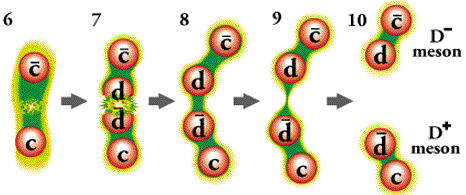Electron/Positron Annihilation




When an electron and positron (antielectron)
collide at high energy they can annihilate to produce
D+ and D- mesons (charm particles).

- Frame 1: The electron and positron zoom towards their certain doom.
- Frame 2: They collide and annihilate,
releasing tremendous amounts of energy.
- Frame 3: The electron and positron
have annihilated into a virtual photon, or a virtual
Z particle, both of which are
virtual force carrier particles.
- Frame 4: A charm quark and a charm
antiquark emerge from the virtual force carrier particle.
- Frame 5: They begin moving apart, stretching the
color force field (gluon field) between them.

- Frame 6: The quarks move apart, further spreading their force field.
- Frame 7: The energy in the
force field increase with the separation between the quarks.
When there is sufficient energy in the
force field, the energy is converted into a
quark and an anti-quark
(remember
 ).
).
- Frames 8-10: The quarks separate into
distinct, color-neutral particles: the
D+
(a charm and anti-down quark) and
D-
(an anti-charm and down quark) mesons.
The intermediate stages
of this process occur in less than almost a
billionth of a billionth of a billionth of a second, and are not observable.

 You can see this as an
ANIMATION
if you are using Netscape.
Depending on your network speed,
loading the animation can be quite slow (but worthwhile!).
You can see this as an
ANIMATION
if you are using Netscape.
Depending on your network speed,
loading the animation can be quite slow (but worthwhile!).
To understand why specific
quarks need to bind together, it is necessary to understand
Quark Confinement.
More about
antimatter.
 Either use your browser's "back" button
Either use your browser's "back" button
or click on this button to return to the
decay path.


![]() Either use your browser's "back" button
Either use your browser's "back" button